Solar eclipse of July 13, 2075
An annular solar eclipse will occur on July 13, 2075. A solar eclipse occurs when the Moon passes between Earth and the Sun, thereby totally or partly obscuring the image of the Sun for a viewer on Earth. An annular solar eclipse occurs when the Moon's apparent diameter is smaller than the Sun's, blocking most of the Sun's light and causing the Sun to look like an annulus (ring). An annular eclipse appears as a partial eclipse over a region of the Earth thousands of kilometers wide.
| Solar eclipse of July 13, 2075 | |
|---|---|
 Map | |
| Type of eclipse | |
| Nature | Annular |
| Gamma | 0.6583 |
| Magnitude | 0.9467 |
| Maximum eclipse | |
| Duration | 285 sec (4 m 45 s) |
| Coordinates | 63.1°N 95.2°E |
| Max. width of band | 262 km (163 mi) |
| Times (UTC) | |
| Greatest eclipse | 6:05:44 |
| References | |
| Saros | 147 (26 of 80) |
| Catalog # (SE5000) | 9676 |
An annular eclipse will cross Europe and Russia. Eight European capitals will observe annual eclipse: Monaco, San Marino, Ljubljana, Zagreb, Vienna, Bratislava, Budapest and Moscow. For Moscow it will be the first central eclipse since 1887. Other European large cities (non-capitals), in which the annular eclipse will seen, include Barcelona, Marseille, Genoa, Graz, Lviv, Nizhny Novgorod, Kirov.
Related eclipses
Solar eclipses 2073–2076
This eclipse is a member of a semester series. An eclipse in a semester series of solar eclipses repeats approximately every 177 days and 4 hours (a semester) at alternating nodes of the Moon's orbit.[1]
| 122 | February 7, 2073 Partial |
127 | August 3, 2073 Total |
| 132 | January 27, 2074 Annular |
137 | July 24, 2074 Annular |
| 142 | January 16, 2075 Total |
147 | July 13, 2075 Annular |
| 152 | January 6, 2076 Total |
157 | July 1, 2076 Partial |
Saros 147
Solar saros 147, repeating every about 18 years and 11 days, contains 80 events. The series started with a partial solar eclipse on October 12, 1624. It has annular eclipses from May 31, 2003, to July 31, 2706. There are no total eclipses in this series. The series ends at member 80 as a partial eclipse on February 24, 3049. The longest annular eclipse will be on November 21, 2291, at 9 minutes and 41 seconds.[2]
| Series members 17–27 occur between 1901 and 2100: | ||
|---|---|---|
| 17 | 18 | 19 |
 April 6, 1913 |
 April 18, 1931 |
 April 28, 1949 |
| 20 | 21 | 22 |
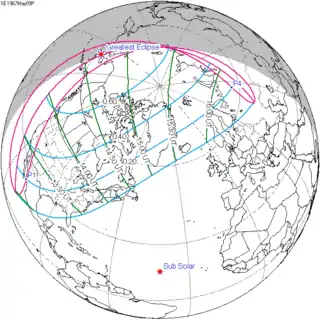 May 9, 1967 |
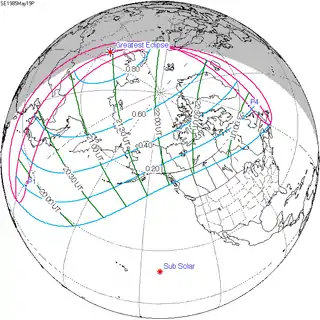 May 19, 1985 |
 May 31, 2003 |
| 23 | 24 | 25 |
 June 10, 2021 |
 June 21, 2039 |
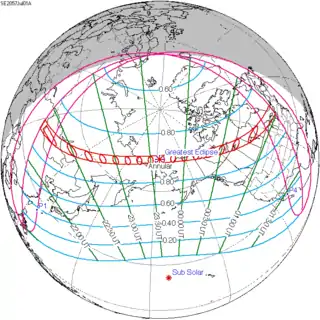 July 1, 2057 |
| 26 | 27 | |
 July 13, 2075 |
 July 23, 2093 | |
Inex series
This eclipse is a part of the long period inex cycle, repeating at alternating nodes, every 358 synodic months (≈ 10,571.95 days, or 29 years minus 20 days). Their appearance and longitude are irregular due to a lack of synchronization with the anomalistic month (period of perigee). However, groupings of 3 inex cycles (≈ 87 years minus 2 months) comes close (≈ 1,151.02 anomalistic months), so eclipses are similar in these groupings.
| Inex series members between 1901 and 2100: | ||
|---|---|---|
 November 11, 1901 (Saros 141) |
 October 21, 1930 (Saros 142) |
 October 2, 1959 (Saros 143) |
 September 11, 1988 (Saros 144) |
 August 21, 2017 (Saros 145) |
 August 2, 2046 (Saros 146) |
 July 13, 2075 (Saros 147) |
||
Metonic series
The metonic series repeats eclipses every 19 years (6939.69 days), lasting about 5 cycles. Eclipses occur in nearly the same calendar date. In addition, the octon subseries repeats 1/5 of that or every 3.8 years (1387.94 days). All eclipses in this table occur at the Moon's ascending node.
| 21 eclipse events, progressing from south to north between July 13, 2018 and July 12, 2094 | ||||
|---|---|---|---|---|
| July 12–13 | April 30-May 1 | February 16–17 | December 5–6 | September 22–23 |
| 117 | 119 | 121 | 123 | 125 |
 July 13, 2018 |
 April 30, 2022 |
 February 17, 2026 |
 December 5, 2029 |
 September 23, 2033 |
| 127 | 129 | 131 | 133 | 135 |
 July 13, 2037 |
 April 30, 2041 |
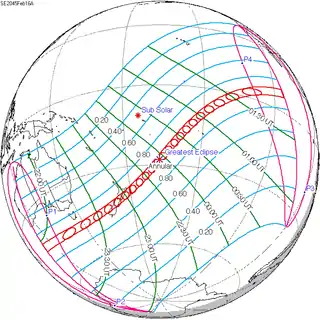 February 16, 2045 |
 December 5, 2048 |
 September 22, 2052 |
| 137 | 139 | 141 | 143 | 145 |
 July 12, 2056 |
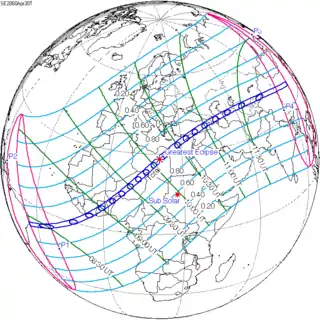 April 30, 2060 |
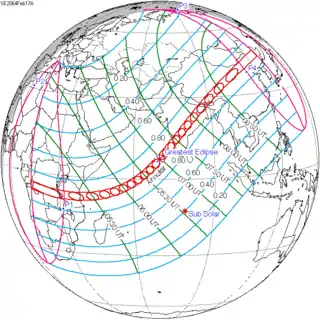 February 17, 2064 |
 December 6, 2067 |
 September 23, 2071 |
| 147 | 149 | 151 | 153 | 155 |
 July 13, 2075 |
 May 1, 2079 |
 February 16, 2083 |
 December 6, 2086 |
 September 23, 2090 |
| 157 | ||||
 July 12, 2094 | ||||
References
- van Gent, R.H. "Solar- and Lunar-Eclipse Predictions from Antiquity to the Present". A Catalogue of Eclipse Cycles. Utrecht University. Retrieved 6 October 2018.
- Saros Series Catalog of Solar Eclipses NASA Eclipse Web Site.
External links
- Earth visibility chart and eclipse statistics Eclipse Predictions by Fred Espenak, NASA/GSFC
.jpg.webp)

